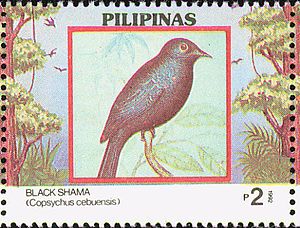Cebushama
| Cebushama | ||||||||||||
|---|---|---|---|---|---|---|---|---|---|---|---|---|

Cebuschama ( Copsychus cebuensis ) |
||||||||||||
| Systematics | ||||||||||||
|
||||||||||||
| Scientific name | ||||||||||||
| Copsychus cebuensis | ||||||||||||
| ( Steere , 1890) |
The Cebuschama ( Copsychus cebuensis , syn .: Kittacincla cebuensis ), also known as Cebu-Dajal , is a songbird species from the flycatcher family (Muscicapidae). It used to be part of the thrush family (Turdidae) and at times it was considered a subspecies of the Moorish eel ( Copsychus niger ). It is endemic to the Philippines island of Cebu .
features
The Cebuschama reaches a length of 20 cm. The male's plumage is predominantly black with a dark blue sheen. The wings are duller in color and can have a slight brown tint. The female is smaller than the male and has a blackish-gray plumage. The long tail is tiered, the beak is black, and the eyes are dark brown. Juvenile birds are more greyish with brownish-black wings.
Vocalizations
The singing is varied and melodious. Occasionally the Cebuschama imitates the song of other bird species.
Habitat and way of life
The Cebuschama is a resident bird . Their way of life is inconspicuous - you often hear them before you see them. The habitat is primary forests and the dense undergrowth of secondary habitats, including scrub forests, logging forests, plantations, and bamboo groves.
The breeding season extends from February to September. Brooding females were observed in June, a female laying eggs in April, a juvenile female in June, a male with enlarged testicles in July and an immature male in October. The bowl-shaped nest is often built at the ends of sawed or broken bamboo stems. The clutch consists of two to three eggs.
The species feeds on insects, including beetles.
Existence and endangerment
At the beginning of the 20th century, the Cebuschama was described as very rare. In the 1930s, the Japanese ornithologist Masauji Hachisuka described them as the rarest of all Filipino shamas. Although the Filipino zoologist Dioscoro S. Rabor noted in 1959 that the Cebuschama was the only surviving of the ten native bird taxa Cebus, there was no confirmed evidence of this species between July 1956, when a male was caught, and November 1981. BirdLife International classifies the Black Shama in the category of "high risk" ( endangered ) and estimates the stock to 1,000 to 5,000 adult birds. Intensive field work since the 1990s has shown that the Cebuschama occurs in at least 15 places on Cebu, with a 700 hectare forest area near Nug-as with probably 2500 specimens having the largest population. The main threat comes from forest destruction. Today only 15 km² of Cebus are covered with forest, which is threatened by illegal clearing.
Individual evidence
- ^ McGregor, RC (1909-1910) A manual of Philippine birds . Manila: Bureau of Printing, p. 563
- ^ Hachisuka, M. (1936) Oiseaux rares ou remarquables des lles Philippines . Oiseau et RFO 6, pp. 185-197, 418-412.
- ^ Rabor, DS (1959) The impact of deforestation on birds of Cebu, Philippines . The Auk, 78 (1), pp. 37-43.
literature
- Josep del Hoyo , Andrew Elliott, David A. Christie: Handbook of the Birds of the World. Volume 10: Cuckoo-shrikes to Thrushes. Lynx Edicions, Barcelona 2005, ISBN 978-84-87334-72-6 .
Web links
- BirdLife Species factsheet
- Threatened Birds of Asia - Copsychus cebuensis (PDF file; 402 kB)
- photos
- ARKive - Pictures and information on Copsychus cebuensis
- Kittacincla cebuensis in the endangered Red List species the IUCN 2013.1. Listed by: BirdLife International, 2012. Retrieved October 15, 2013.